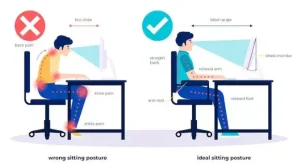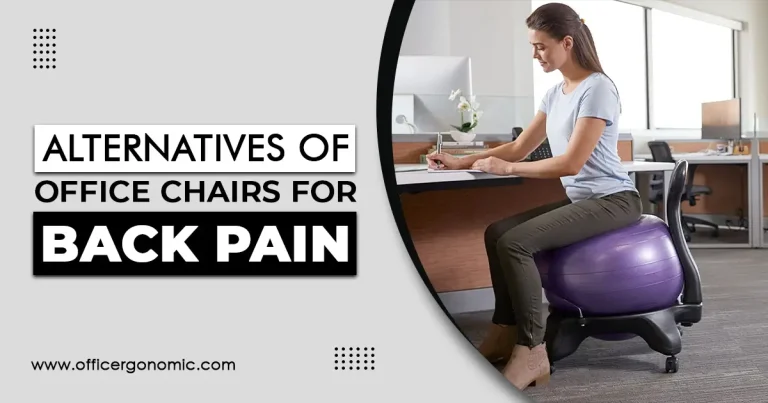How Poor Ergonomics is a Cause of Sciatica?
How poor ergonomics is a cause of sciatica? It is easily possible to develop sciatica as a result of poor ergonomics. This is because a slouchy and bad posture for prolonged periods puts strain on the lower back which is one of the prominent sciatica symptoms. because they are the leading cause of back pain.
Ergonomic design is meant to make office chairs comfortable, increase productivity and keep you safe. The most comfortable chairs support the curves of your spine and keep you in a neutral position. Consider sitting with your back straight, feet flat on the ground or footrest, with screens at your eye level.
Even after changing your seating position doesn’t make a difference, visit a doctor and seek professional help. This article will outline some of the ways you can prevent chronic back pain and sciatica. So, keep reading!
How Poor Ergonomics is a Cause of Sciatica?
Sciatica is a painful condition that affects the lower back and goes all the way down to the toes passing from the entire leg. It particularly affects the sciatic nerve that is running along the back of your hip and around your buttocks. It runs through a muscle known as the piriformis muscle that bears the maximum pressure of the human body when a person sits.
Constant pressure on piriformis muscles makes them move into the spasm. Being in the closest proximity to piriformis muscles, the sciatic nerve is at a higher risk of getting compacted when a person sits for long periods regularly. This directly leads to developing sciatica pain symptoms over time.
Can Sitting at a Desk Cause Sciatica?
Yes, it can cause sciatica and be very painful because of the incorrect sitting position. Sciatica could directly result from poor posture, improper sitting positions, and a lack of physical activity with prolonged sitting.
Lower back pain is expected due to poor ergonomics, sitting and standing for long periods, and injuries from previous traumas that have not healed properly.
Sitting in an improper position at your desk or when using a computer can cause numbness or tingling in the legs and lead to leg pain or back pain.
When people have prolonged bad posture, this will lead to tension on the lumbar spine from sitting in an incorrect position. The longer you sit like that, the more likely you are to develop back problems such as herniated discs and sciatica in your back.
Things To Consider For Avoiding Sciatica Pain
If you feel like you are facing any of the issues mentioned earlier, it’s time to sit down and make a list of things you can do to control them. Here are a few things that can help prevent sciatica pain.
1. Use an Ergonomic Chair
A good ergonomic office chair with the right shape and height to support your spine while providing good lumbar support will significantly improve your comfort level and reduce pain. Sitting on a chair with a back that curves up rather than down can cause your lower spine to curve.
The most effective way to sit correctly is to place your feet firmly on the floor, both back and bottom, and sit up straight in your chair. You shouldn’t slouch forward and put all your weight on your lower back because that can contribute to developing sciatica.
In this regard, kneeling chairs are considered a perfect fit as they offer many benefits including even weight distribution, reduced back pressure, improved blood circulation, and many others. You can check out other ergonomic chairs as well.
2. Position Screens Appropriately
Another important consideration is to position screens appropriately so as to keep your neck and upper body comfortable. If you have your monitor placed at a desk, make sure to keep the screen as far away from your face as possible and tilted slightly to the left. The monitor should be positioned at eye level or higher.
People using more than one monitor, even then make sure that they are all placed directly at your eye level. Along with that, take regular breaks in between work sessions for releasing the strain on your shoulders and back area. Taking a break from work and moving around can relieve lower back pain because it allows you to stretch your muscles.
3. Place Keyboards at a Proper Height
A keyboard that is the proper height and far enough from your neck will help reduce pain in your hands and wrists. If you have hand or wrist issues, it’s a good idea to consider typing tools like ergonomic keyboards. This will keep you from bending your wrists while typing and reduce stress on the muscles in your hands.
When sitting at your desk, try to place the keyboard at elbow level and your mouse close by so you can keep your upper body in a neutral position. This will help avoid bending forward and causing lower back pain.
Keyboards sometimes tend to be lower than elbows level because the time we spend using them and placing them lower or on a separate keyboard tray can make a world of difference when preventing back pain.
Best Sitting Position for Sciatica Pain
First, it’s essential to be aware of the bad ergonomic posture habits that cause pain in your lower back and increase fatigue. Once you know the causes, you can do a number of things for restructuring your seating, such as:
- It would help if you always sat up straight while sitting and should avoid slouching your shoulders forward or resting along your chest and leaning all of your weight on the lower back.
- Sitting with your head and back straight is the best sitting position for sciatica.
- When using a laptop or computer, it’s essential to ensure that your seat doesn’t put too much pressure on the lower back and hamstrings. It would be best if you also looked for a chair with adjustable lumbar support because sitting all day is unsuitable for the lower back.
- Place your feet flat on the floor and your rear end on the chair. You may also rest on a thin pillow or a small cushion to keep the spine in alignment while sitting.
- You may want to try sitting in different positions to see which one is best for your back and which position minimizes pain. You should also place pillows on either side of your lower back and try to cushion the lower spine by sitting up straight in your chair.
- If you have a desk job, you might want an adjustable desk that will help tilt the desk and raise it up or down, depending on your back pain and how bad it has become.
How to Cure Sciatica Permanently?
There are many ways that can help you with sciatica condition, and that’s by using natural remedies. However, you can take medical advice for this sensitive health issue. There are two primary surgical treatments known as diskectomy and laminectomy. These take the source of the pain away from you.
The approach for healing by using natural remedies is milder and more specific for this condition. Using a natural approach, you can effectively reduce and eliminate sciatica pain in your back. In addition, you also restore your health without harmful side effects and prevent the recurrence of this condition.
Last Thoughts!
As you can see, understanding your sciatica pain and knowing the causes of back pain will help you recognize the proper way to position your body to achieve comfort. This will also work for pain relief of sciatica patients and lessen inflammation around the nerve root where it exits the spinal canal.
Obviously, this may not be an overnight fix for sciatica. It can take several weeks or even months to get the result you want from the proper exercises and precautions. But be patient and understand that consistency works wonders when working towards a better sciatica solution.










